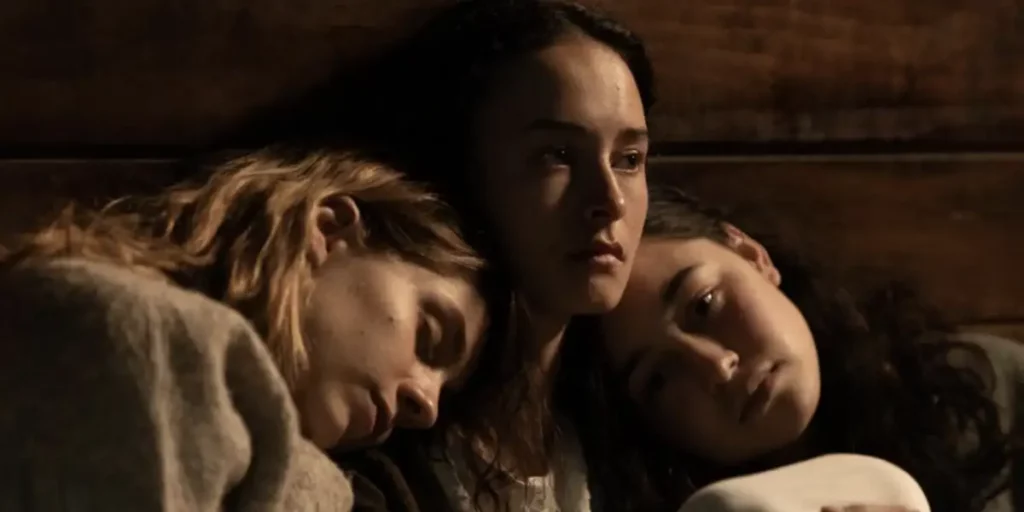Amidst inhumane conditions at an isolated reform school in 1950s New Zealand, We Were Dangerous demonstrates women’s empowerment and the beauty of friendship.
As I was watching We Were Dangerous, I couldn’t help but wonder if reform schools—which the film’s characters are sent to—still exist today. A quick Google search revealed that they do. However, should one be shipped off to such an establishment in today’s world, one can only hope the institution isn’t on a remote island, far away from family, friends, and civilization.
Josephine Stewart-Te Whiu’s We Were Dangerous centers around Nellie (Erana James) and Daisy (Manaia Hall), who attend the School for Incorrigible and Delinquent Girls in 1950s New Zealand. The institution is run by a stern headmistress, the Matron (Rima Te Wiata). She is small-minded and believes that wifehood is all these women have to offer the world. Enraged by such ideals, Nellie, Daisy, and a pregnant student devise a plan to escape the school for good. However, their idea goes horribly wrong. In the aftermath of the incident, one of the school’s male chauvinist leaders suggests that the Matron relocate the girls to a remote New Zealand island. The man in question even proclaims, “If it were up to me, I’d keep them there until the menopause.” All the school’s students are shipped off to their new remote dwelling. However, on their new island, tensions rise as Nellie and Daisy, along with their new friend Lou (Nathalie Morris), uncover some horrifying experiments being performed on some of the students come nightfall.
One thing that immediately stood out to me while watching We Were Dangerous is how picturesque the setting is. The film delivers gorgeous visuals, and the noteworthy aesthetics elevate the material and instill hope for the future even when the narrative is seemingly bleak. The mountains and trees tower over the island, further reflecting isolation and an existence far away from humanity. The girls’ lives are restrictive, but their strong bond and an alluring setting are somewhat of a beautiful tragedy, and the film’s complementary sound design only adds to We Were Dangerous’ worldbuilding. The girl’s institution is reminiscent of old Victorian boarding schools, and the set design effectively complements and conveys the film’s time period. All the students wear a school uniform, and everything is oh-so prim and proper.
When exploring each of the film’s characters, We Were Dangerous takes time to detail and unravel Nellie, Daisy, and Lou’s past. This allows viewers to learn more about their upbringing and what led them to become students at the school in the first place. As opposed to each of the girls narrating their own backstory, the Matron does. This is a unique approach and further reflects the headmistress’s control over the girls. Nellie and Daisy have been friends for quite some time. However, their stealing antics are what landed them in the reform school.

After moving to the island, they befriend Lou. The Matron claims that she had a sexually promiscuous past, though we never really know if we can trust our narrator’s skewed point of view. Speaking of the Matron, Te Wiata’s performance is undeniably the best. The headmistress is a wicked, emotionless character that you immediately dislike, and the actress’s villainous portrayal of our antagonist isn’t one I will forget anytime soon. James, Hall, and Morris each give noteworthy performances and have fantastic chemistry. The bond the three characters share is realistic and empowering while bringing a lot of emotion and charm to the film.
My only criticism is that I wish We Were Dangerous’ runtime had been slightly longer. When the climax arrives, which is the most engrossing part of the film, the payoff is somewhat underwhelming and the resolution abruptly ends. Ideally, the feature would have fleshed out its third act more and worked towards a more satisfying conclusion instead of rushing to the finish line.
That said, We Were Dangerous is a memorable feature, showcasing the importance of deep and meaningful friendships and how vital and empowering women in numbers fighting for justice can be.
We Were Dangerous will be screened at SXSW on March 8-13, 2024. Read our SXSW reviews!
